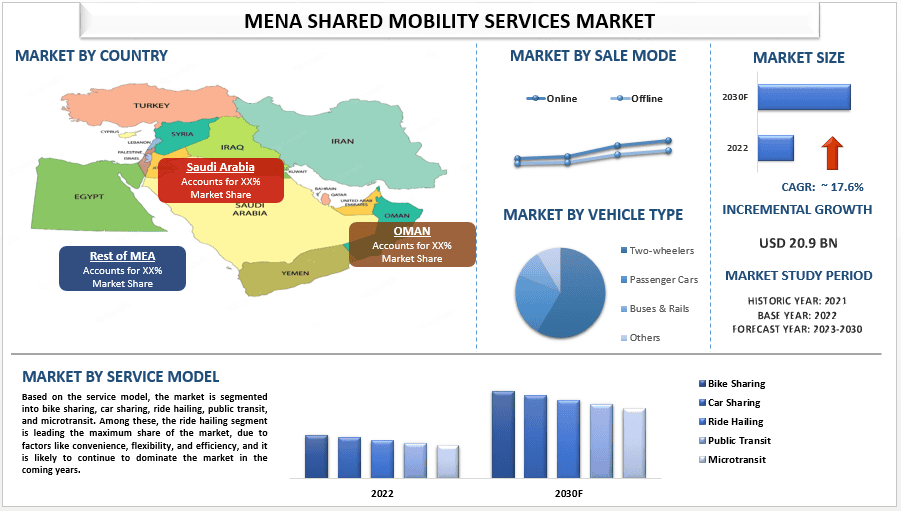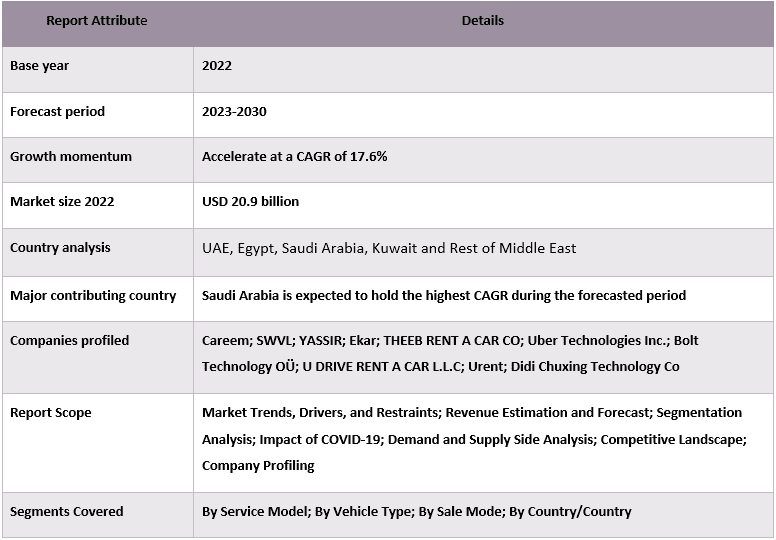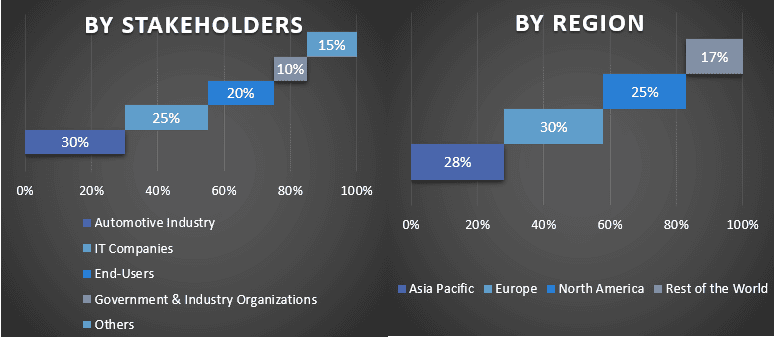- Home
- About Us
- Industry
- Services
- Reading
- Contact Us
MENA Shared Mobility Services Market: Current Analysis and Forecast (2023-2030)
Emphasis on Service Model (bike sharing, car sharing, ride hailing, public transit, and microtransit); Vehicle Type (two-wheelers, passenger cars, buses & rails, and others); and Sale Mode (online, and offline) and Region/Country

The MENA Shared Mobility Services Market was valued at 20.9 billion in 2022 and is expected to grow at a steady rate of around 17.6% in the forecasted period (2023-2030) owing to the increasing urbanization. The Shared Mobility Services Market refers to the industry that provides various forms of shared transportation services to individuals, including ride-sharing, car-sharing, bike-sharing, and scooter-sharing. These services are designed to provide an affordable and sustainable transportation option for people who do not own a personal vehicle or prefer not to use one. Shared mobility services are an essential part of the transportation landscape, and they offer many benefits for individuals, communities, and the environment. Furthermore, the market is also driven by rising environmental concerns and the need for more efficient, cost-effective transportation options and government initiatives. For instance, the government of Dubai, located in the United Arab Emirates, plans to introduce 3,500 publicly accessible bicycles throughout the city by 2025, with 350 stations set up to accommodate them.
Some of the major players operating in the market include Careem; SWVL; YASSIR; Ekar; THEEB RENT A CAR CO; Uber Technologies Inc.; Bolt Technology OÜ; U DRIVE RENT A CAR L.L.C; Urent; Didi Chuxing Technology Co
Insights Presented in the Report
“Amongst service model, ride hailing category to witness significant market growth during the forecast period.”
Based on the service model, the market is segmented into bike sharing, car sharing, ride hailing, public transit, and microtransit. Among these, the ride hailing segment is leading the maximum share of the market, due to factors like convenience, flexibility, and efficiency, and it is likely to continue to dominate the market in the coming years.
“Amongst sale mode, online category to have a considerable share of the market during the forecast period.”
Based on sale mode, the market is bifurcated into online and offline. Among these, the online segment is leading the market because it offers a more convenient and efficient way for users to access and use shared mobility services. Online platforms, such as ride-hailing apps, allow users to easily request a ride, track the driver’s location, and pay for the service through a mobile app. This allows users to plan and schedule their trips in advance and to have a more seamless and streamlined experience. For instance, the number of online cab booking users in Saudi Arabia will reach 2.7 million by 2025, up from 1.4 million in 2020.
“Saudi Arabia to hold a significant share in the market.”
Saudi Arabia is anticipated to hold a significant share of the market in the forecasted year as the region is experiencing significant growth in urbanization, which is leading to an increase in the demand for convenient and efficient transportation options. Additionally, the adoption of smartphones in the Saudi Arabia region has been growing rapidly, and this has facilitated the growth of the ride-hailing market. Smartphones enable users to easily book rides, track the location of vehicles, and make payments. Also, the Saudi Arabia government has been supportive of the growth of the ride-hailing market, and has introduced several policies and regulations to promote the adoption of shared mobility services. For example, the government has introduced a regulatory framework for ride-hailing companies, and has offered incentives for the adoption of electric and hybrid vehicles.
MENA Shared Mobility Services Market Report Coverage

Reasons to buy this report:
- The study includes market sizing and forecasting analysis validated by authenticated key industry experts.
- The report presents a quick review of overall industry performance at one glance.
- The report covers an in-depth analysis of prominent industry peers with a primary focus on key business financials, product portfolio, expansion strategies, and recent developments.
- Detailed examination of drivers, restraints, key trends, and opportunities prevailing in the industry.
- The study comprehensively covers the market across different segments.
- Deep dive country level analysis of the industry.
Customization Options:
The MENA Shared Mobility Services Market can further be customized as per the requirement or any other market segment. Besides this, UMI understands that you may have your own business needs, hence feel free to connect with us to get a report that completely suits your requirements.
Table of Content
Research Methodology for the MENA Shared Mobility Services Market Analysis (2023-2030)
Analyzing the historical market, estimating the current market, and forecasting the future market of the MENA Shared Mobility Services Market were the three major steps undertaken to create and analyze the adoption of MENA Shared Mobility Services in major countries. Exhaustive secondary research was conducted to collect the historical market numbers and estimate the current market size. Secondly, to validate these insights, numerous findings and assumptions were taken into consideration. Moreover, exhaustive primary interviews were also conducted, with industry experts across the value chain of the MENA Shared Mobility Services Market. Post assumption and validation of market numbers through primary interviews, we employed a top-down/bottom-up approach to forecasting the complete market size. Thereafter, market breakdown and data triangulation methods were adopted to estimate and analyze the market size of segments and sub-segments of the industry pertains to. Detailed methodology is explained below:
Analysis of Historical Market Size
Step 1: In-Depth Study of Secondary Sources:
Detail secondary study was conducted to obtain the historical market size of the MENA Shared Mobility Services Market through company internal sources such as annual reports & financial statements, performance presentations, press releases, etc., and external sources including journals, news & articles, government publications, competitor publications, sector reports, third-party database, and other credible publications.
Step 2: Market Segmentation:
After obtaining the historical market size of the MENA Shared Mobility Services Market, we conducted a detailed secondary analysis to gather historical market insights and share for different segments & sub-segments for major countries. Major segments are included in the report as service model, vehicle type, and sale mode. Further country-level analyses were conducted to evaluate the overall adoption of testing models in that country.
Step 3: Factor Analysis:
After acquiring the historical market size of different segments and sub-segments, we conducted a detailed factor analysis to estimate the current market size of the MENA Shared Mobility Services Market. Further, we conducted factor analysis using dependent and independent variables such as various service model, vehicle type, and sale mode of The MENA Shared Mobility Services. A thorough analysis was conducted for demand and supply-side scenarios considering top partnerships, mergers and acquisitions, business expansion, and product launches in the MENA Shared Mobility Services Market sector across the globe.
Current Market Size Estimate & Forecast
Current Market Sizing: Based on actionable insights from the above 3 steps, we arrived at the current market size, key players in the MENA Shared Mobility Services Market, and market shares of the segments. All the required percentage shares split, and market breakdowns were determined using the above-mentioned secondary approach and were verified through primary interviews.
Estimation & Forecasting: For market estimation and forecast, weights were assigned to different factors including drivers & trends, restraints, and opportunities available for the stakeholders. After analyzing these factors, relevant forecasting techniques i.e., the top-down/bottom-up approach were applied to arrive at the market forecast for 2030 for different segments and sub-segments across the major markets. The research methodology adopted to estimate the market size encompasses:
- The industry’s market size, in terms of revenue (USD) and the adoption rate of the MENA Shared Mobility Services Market across the major markets domestically
- All percentage shares, splits, and breakdowns of market segments and sub-segments
- Key players in the MENA Shared Mobility Services Market in terms of products offered. Also, the growth strategies adopted by these players to compete in the fast-growing market
Market Size and Share Validation
Primary Research: In-depth interviews were conducted with the Key Opinion Leaders (KOLs) including Top Level Executives (CXO/VPs, Sales Head, Marketing Head, Operational Head, Country Head, Country Head, etc.) across major countries. Primary research findings were then summarized, and statistical analysis was performed to prove the stated hypothesis. Inputs from primary research were consolidated with secondary findings, hence turning information into actionable insights.
Split of Primary Participants in Different Countries

Market Engineering
The data triangulation technique was employed to complete the overall market estimation and to arrive at precise statistical numbers for each segment and sub-segment of the MENA Shared Mobility Services Market. Data was split into several segments & sub-segments post studying various parameters and trends in the areas of service model, vehicle type, and sale mode in the MENA Shared Mobility Services Market.
The main objective of the MENA Shared Mobility Services Market Study
The current & future market trends of the MENA Shared Mobility Services Market were pinpointed in the study. Investors can gain strategic insights to base their discretion for investments on the qualitative and quantitative analysis performed in the study. Current and future market trends determined the overall attractiveness of the market at a country level, providing a platform for the industrial participant to exploit the untapped market to benefit from a first-mover advantage. Other quantitative goals of the studies include:
- Analyze the current and forecast market size of the MENA Shared Mobility Services Market in terms of value (USD). Also, analyze the current and forecast market size of different segments and sub-segments
- Segments in the study include areas of service model, vehicle type, and sale mode.
- Define and analysis of the regulatory framework for the MENA Shared Mobility Services industry.
- Analyze the value chain involved with the presence of various intermediaries, along with analyzing customer and competitor behaviors of the industry.
- Analyze the current and forecast market size of the MENA Shared Mobility Services Market for the major country.
- Major countries of countries studied in the report include UAE, Egypt, Saudi Arabia, Kuwait, and Rest of Middle East region.
- Company profiles of the MENA Shared Mobility Services Market and the growth strategies adopted by the market players to sustain in the fast-growing market.
- Deep dive country level analysis of the industry.
Related Reports
Customers who bought this item also bought










